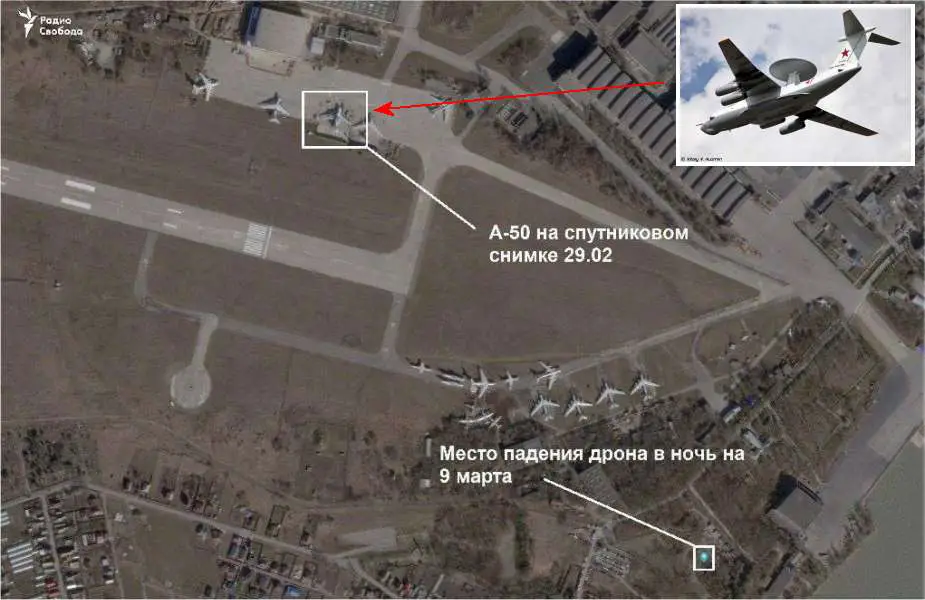- Army
- Conflicts in the world
- Israel - Iran conflict 2025
- Pakistan - India Conflict 2025
- Russia Ukraine War 2022
- Libya conflict day by day
- HAMAS - Israel War 2023
- Operation Serval in Mali French Army
- Sangaris operation Central African Republic
- Sangaris opération militaire République Centreafrique
- Ukraine - Russia conflict
- Syria conflict news
- Defence & Security Industry Technology
- Armies in the world
- Analysis Defense and Security Industry
- Conflicts in the world
- Navy
- Air
Breaking News: Ukrainian Drones Strike Russian A-50 AWACS Aircraft Facility in Taganrog Russia
On March 9, 2024, Ukrainian forces launched a sophisticated drone attack on the Beriev Aircraft Company in Taganrog, Russia. This strike targeted a key facility involved in the modernization of Russia's A-50 AWACS aircraft, dealing a significant blow to the Russian military's aerial surveillance capabilities.
Follow Army Recognition on Google News at this link

One of the Ukrainian kamikaze UAVs detonated 900 meters away from a location where a Russian A-50 long-range radar reconnaissance aircraft had been identified in satellite imagery. (Picture source X account Ukrainian Front)
The Beriev Aircraft Company, a cornerstone of the Russian aviation industry since its founding in 1934 by Georgy Mikhailovich Beriev, specializes in the design and production of amphibious aircraft. Over the decades, it has evolved to serve both civilian and military needs, producing more than 20 different aircraft models, including the A-50.
This latest assault, carried out by a swarm of Ukrainian Liutyi UAVs, reportedly led to the destruction of the facility on the morning of March 9, 2024. The operation signifies a notable intensification in Ukraine's military strategy, employing kamikaze drones to inflict considerable damage on Russian military infrastructure.
The city of Taganrog witnessed powerful explosions and the deployment of a large number of these kamikaze drones, underscoring the attack's intensity and precision. Notably, one of these drones detonated merely 900 meters away from a location where an A-50 aircraft was previously identified through satellite imagery, highlighting the targeted nature of the strike.
This event follows a series of engagements between Ukrainian and Russian forces involving the Beriev A-50 aircraft. Notably, the Ukrainian Air Force claimed the downing of an A-50U variant near the Sea of Azov on February 23, 2024, with a Soviet-era S-200 air defense missile system. A similar incident was reported on January 14, 2024, marking a pattern of strategic targeting by Ukrainian forces against Russian aerial reconnaissance assets.
The full extent of the damage and the broader implications of the attack on Taganrog's Beriev Aircraft Company remains uncertain. However, this bold move by Ukrainian forces represents a significant escalation in their operational tactics, demonstrating a capacity and willingness to strike deep within Russian territory and target critical military assets. This incident not only signifies a tactical evolution in the conflict but also underscores the ongoing volatility and complexity of the situation in the region.
In the ongoing conflict, the decision by Ukrainian forces to target Russian A-50 aircraft underscores a tactical shift towards undermining a critical component of the adversary's military capabilities. The A-50, an advanced Airborne Warning and Control System (AWACS) aircraft, plays a pivotal role in the Russian military's ability to conduct all-weather surveillance, command, control, and communications. By focusing on these aircraft, Ukraine aims to significantly impact Russia's operational effectiveness in several key areas.
Firstly, the destruction or incapacitation of A-50s directly affects Russia's airborne command and control capabilities. These aircraft are central to coordinating military operations across vast distances, offering real-time data and communication support to both ground and air units. Without the strategic oversight provided by the A-50, Russian forces may face challenges in maintaining situational awareness, resulting in decreased cohesion and effectiveness in coordinated military efforts.
Moreover, the A-50's role in early warning and surveillance cannot be overstated. It acts as a critical asset for detecting incoming air threats, including aircraft and missiles, thereby enabling preemptive defensive measures. By diminishing Russia's early warning capabilities, Ukraine could gain a tactical advantage, potentially increasing the effectiveness of its own offensive operations and reducing the efficacy of Russian defensive responses.
The targeting strategy also serves as a psychological blow to the Russian military, signaling Ukraine's capability and willingness to strike key assets deep within Russian territory. Such actions not only demonstrate Ukraine's growing military sophistication and resolve but also aim to deter further aggression by showcasing the vulnerabilities in Russian military infrastructure.
Ukraine's focus on neutralizing Russian A-50 aircraft is a calculated move to erode the technological and operational advantages held by its adversary. This approach is indicative of a broader strategy to disrupt key military capabilities, thereby leveling the playing field and potentially altering the course of the conflict in Ukraine's favor.
News Russia Ukraine War


























